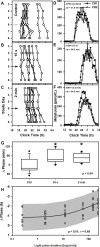Circadian phase resetting by a single short-duration light exposure
- PMID: 28405608
- PMCID: PMC5374060
- DOI: 10.1172/jci.insight.89494
Circadian phase resetting by a single short-duration light exposure
Abstract
BACKGROUND. In humans, a single light exposure of 12 minutes and multiple-millisecond light exposures can shift the phase of the circadian pacemaker. We investigated the response of the human circadian pacemaker to a single 15-second or 2-minute light pulse administered during the biological night. METHODS. Twenty-six healthy individuals participated in a 9-day inpatient protocol that included assessment of dim light melatonin onset time (DLMO time) before and after exposure to a single 15-second (n = 8) or 2-minute (n = 12) pulse of bright light (9,500 lux; 4,100 K fluorescent) or control background dim light (<3 lux; n = 6). Phase shifts were calculated as the difference in clock time between the two phase estimates. RESULTS. Both 15-second and 2-minute exposures induced phase delay shifts [median (± SD)] of -34.8 ± 47.2 minutes and -45.4 ± 28.4 minutes, respectively, that were significantly (P = 0.04) greater than the control condition (advance shift: +22.3 ± 51.3 minutes) but were not significantly different from each other. Comparisons with historic data collected under the same conditions confirmed a nonlinear relationship between exposure duration and the magnitude of phase shift. CONCLUSIONS. Our results underscore the exquisite sensitivity of the human pacemaker to even short-duration single exposures to light. These findings may have real-world implications for circadian disruption induced by exposure to brief light stimuli at night. TRIAL REGISTRATION. The study was registered as a clinical trial on www.clinicaltrials.org, NCT #01330992. FUNDING. Funding for this study was provided by NSBRI HFP02802 and NIH P01-AG09975, R01-HL114088 (EBK), RC2-HL101340-0 (EBK, SWL, SAR, REK), K02-HD045459 (EBK), K24-HL105664 (EBK), T32-HL07901 (MSH, SAR), HL094654 (CAC), and AG044416 (JFD). The project described was supported by NIH grant 1UL1 TR001102-01, 8UL1TR000170-05, UL1 RR 025758, Harvard Clinical and Translational Science Center, from the National Center for Advancing Translational Science.
Conflict of interest statement
Conflict of interest: Possible conflicts of interest for all authors are disclosed in the online supplement (https://doi.org/10.1172/jci.insight.89494DS1).
Figures



Similar articles
-
Efficacy of a single sequence of intermittent bright light pulses for delaying circadian phase in humans.Am J Physiol Endocrinol Metab. 2004 Jul;287(1):E174-81. doi: 10.1152/ajpendo.00385.2003. Epub 2004 Mar 23. Am J Physiol Endocrinol Metab. 2004. PMID: 15039146 Free PMC article. Clinical Trial.
-
Functional decoupling of melatonin suppression and circadian phase resetting in humans.J Physiol. 2018 Jun;596(11):2147-2157. doi: 10.1113/JP275501. Epub 2018 Apr 29. J Physiol. 2018. PMID: 29707782 Free PMC article.
-
Melatonin rhythm observed throughout a three-cycle bright-light stimulus designed to reset the human circadian pacemaker.J Biol Rhythms. 1999 Jun;14(3):237-53. doi: 10.1177/074873099129000560. J Biol Rhythms. 1999. PMID: 10452336
-
Human responses to bright light of different durations.J Physiol. 2012 Jul 1;590(13):3103-12. doi: 10.1113/jphysiol.2011.226555. Epub 2012 Apr 23. J Physiol. 2012. PMID: 22526883 Free PMC article. Clinical Trial.
-
Melatonin and cancer risk: does light at night compromise physiologic cancer protection by lowering serum melatonin levels?Br J Cancer. 2004 Mar 8;90(5):941-3. doi: 10.1038/sj.bjc.6601626. Br J Cancer. 2004. PMID: 14997186 Free PMC article. Review.
Cited by
-
Lighting the path forward: the value of sleep- and circadian-informed lighting interventions in shift work.Sleep. 2024 Nov 8;47(11):zsae214. doi: 10.1093/sleep/zsae214. Sleep. 2024. PMID: 39301963 Free PMC article. No abstract available.
-
Dynamics of Non-visual Responses in Humans: As Fast as Lightning?Front Neurosci. 2019 Mar 5;13:126. doi: 10.3389/fnins.2019.00126. eCollection 2019. Front Neurosci. 2019. PMID: 30890907 Free PMC article.
-
Time-Varying Light Exposure in Chronobiology and Sleep Research Experiments.Front Neurol. 2021 Jul 15;12:654158. doi: 10.3389/fneur.2021.654158. eCollection 2021. Front Neurol. 2021. PMID: 34335437 Free PMC article. Review.
-
Light exposure during sleep is bidirectionally associated with irregular sleep timing: The multi-ethnic study of atherosclerosis (MESA).Environ Pollut. 2024 Mar 1;344:123258. doi: 10.1016/j.envpol.2023.123258. Epub 2023 Dec 28. Environ Pollut. 2024. PMID: 38159634 Free PMC article.
-
Dynamic lighting schedules to facilitate circadian adaptation to shifted timing of sleep and wake.J Pineal Res. 2022 Aug;73(1):e12805. doi: 10.1111/jpi.12805. Epub 2022 May 25. J Pineal Res. 2022. PMID: 35501292 Free PMC article.
References
-
- Klerman EB, Rimmer DW, Dijk DJ, Kronauer RE, Rizzo JF, Czeisler CA. Nonphotic entrainment of the human circadian pacemaker. Am J Physiol. 1998;274(4 Pt 2):R991–R996. - PubMed
-
- Van Den Pol AN, Cao V, Heller HC. Circadian system of mice integrates brief light stimuli. Am J Physiol. 1998;275(2 Pt 2):R654–R657. - PubMed
Publication types
MeSH terms
Substances
Grants and funding
LinkOut - more resources
Full Text Sources
Other Literature Sources
Research Materials
Miscellaneous

